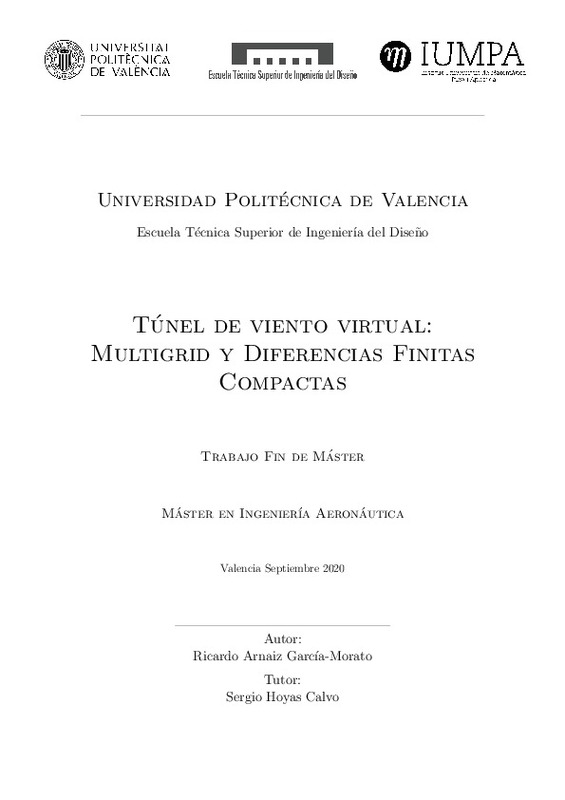JavaScript is disabled for your browser. Some features of this site may not work without it.
Buscar en RiuNet
Listar
Mi cuenta
Estadísticas
Ayuda RiuNet
Admin. UPV
Túnel de viento virtual: multigrid y diferencias finitas compactas
Mostrar el registro sencillo del ítem
Ficheros en el ítem
| dc.contributor.advisor | Hoyas Calvo, Sergio
|
es_ES |
| dc.contributor.author | Arnaiz García-Morato, Ricardo
|
es_ES |
| dc.date.accessioned | 2020-10-15T11:35:34Z | |
| dc.date.available | 2020-10-15T11:35:34Z | |
| dc.date.created | 2020-09-18 | |
| dc.date.issued | 2020-10-15 | es_ES |
| dc.identifier.uri | http://hdl.handle.net/10251/151960 | |
| dc.description.abstract | [ES] La turbulencia es probablemente el problema abierto de la física con más aplicaciones en el día a día. Para poder estudiar un flujo turbulento se deben, o bien resolver las ecuaciones de Navier-Stokes, o bien estudiarlo mediante experimentos en túnel de viento. Los estudios en túnel de viento tienen diferentes inconvenientes, como puede ser el gasto energético o la dificultad de probar varias configuraciones, mientras que la resolución analítica de las ecuaciones de Navier-Stokes es inabordable. La solución es el estudio numérico de las ecuaciones. Existen numerosos métodos para la solución de las ecuaciones de Navier-Stokes, siendo el más preciso la simulación numérica directa, donde no se hace ninguna hipótesis sobre la física del problema, más allá de las que nos llevan a las ecuaciones de Navier-Stokes. El objetivo del trabajo es realizar un método de base para la realización de un túnel de viento virtual. Se tiene, por tanto, que resolver las ecuaciones de Navier-Stokes de la forma más eficiente posible. Para el proyecto del túnel de viento virtual, se ha optado por un método mixto de diferencias finitas compactas ¿ transformada discreta de Fourier para la discretización espacial del dominio. Esto nos lleva a que para resolver el problema, no va a ser necesario resolver una ecuación sino miles de ecuaciones 2D. Al aplicar este método obtenemos un sistema en el que hay que resolver sistemas de ecuaciones del orden de las decenas de millones de puntos. Para resolver este tipo de problemas se ha optado por un sistema multigrid permite resolver grandes sistemas de ecuaciones de manera rápida y eficiente. En este TFM, se ha realizado un estudio de la aplicabilidad del método multigrid y su uso en problemas 2D discretizados mediante el método de las diferencias finitas compactas. | es_ES |
| dc.description.abstract | [EN] Turbulence is probably the open problem in physics with the most applications in daily life. To be able to study turbulent flow you must either solve the Navier-Stokes equations or study it by conducting2 wind tunnel experiments. Wind tunnel studies have different disadvantages, such as the energy expenditure or the difficulty of testing various configurations, while the analytical resolution of the Navier-Stokes equations is unapproachable. The solution is the numerical study of the equations. There are numerous methods for solving the Navier-Stokes equations, the most accurate being direct numerical simulation, where no hypotheses are made about the physics of the problem beyond those that lead to the Navier-Stokes equations. The aim of the work is to make a basic method for the implementation of a virtual wind tunnel. Therefore, the Navier-Stokes equations have to be solved in the most efficient way possible. For the virtual wind tunnel project, a mixed method of compact finite difference - discrete Fourier transform has been chosen for the spatial discretization of the domain. This leads us to the fact that to solve the problem, it will not be necessary to solve one equation but thousands of 2D equations. By applying this method we obtain a system in which we have to solve systems of equations of the order of tens of millions of points. To solve this type of problems we have chosen a multigrid system that allows us to solve large systems of equations quickly and efficiently. In this TFM, a study has been made of the applicability of the multigrid method and its use in discrete 2D problems using the compact finite difference method. | es_ES |
| dc.format.extent | 104 | es_ES |
| dc.language | Español | es_ES |
| dc.publisher | Universitat Politècnica de València | es_ES |
| dc.rights | Reserva de todos los derechos | es_ES |
| dc.subject | Diferencias finitas compactas | es_ES |
| dc.subject | DNS | es_ES |
| dc.subject | CFD | es_ES |
| dc.subject | Multigrid | es_ES |
| dc.subject | Compact finite difference | es_ES |
| dc.subject.classification | INGENIERIA AEROESPACIAL | es_ES |
| dc.subject.other | Máster Universitario en Ingeniería Aeronáutica-Màster Universitari en Enginyeria Aeronàutica | es_ES |
| dc.title | Túnel de viento virtual: multigrid y diferencias finitas compactas | es_ES |
| dc.type | Tesis de máster | es_ES |
| dc.rights.accessRights | Abierto | es_ES |
| dc.contributor.affiliation | Universitat Politècnica de València. Departamento de Máquinas y Motores Térmicos - Departament de Màquines i Motors Tèrmics | es_ES |
| dc.contributor.affiliation | Universitat Politècnica de València. Escuela Técnica Superior de Ingeniería del Diseño - Escola Tècnica Superior d'Enginyeria del Disseny | es_ES |
| dc.description.bibliographicCitation | Arnaiz García-Morato, R. (2020). Túnel de viento virtual: multigrid y diferencias finitas compactas. Universitat Politècnica de València. http://hdl.handle.net/10251/151960 | es_ES |
| dc.description.accrualMethod | TFGM | es_ES |
| dc.relation.pasarela | TFGM\137150 | es_ES |
Este ítem aparece en la(s) siguiente(s) colección(ones)
-
ETSIADI - Trabajos académicos [9133]
Escuela Técnica Superior de Ingeniería Aeroespacial y Diseño Industrial






